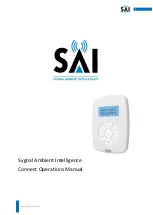
User's Manual l TQMa8XxS UM 0101 l © 2022, TQ-Systems GmbH
Page 20
Table 11:
USB ports
SMARC port
Provided by
Remark
USB0 (2.0 OTG)
i.MX 8X OTG1
Force Recovery Function (USB Serial Downloader)
USB1 (2.0)
USB-Hub Port 1
–
USB2 (3.0)
USB-Hub Port 2
Usable as host only
USB3 (3.0)
USB-Hub Port 3
Can only be used as host; optional i.MX 8X OTG2 (USB 3.0 not provided)
USB4 (2.0)
USB-Hub Port 4
–
USB5 (2.0)
Not used
–
Apart from USB5, all USB interfaces of the SMARC standard are provided. The TUSB8041 USB hub from TI is used for this, which is
an assembly option and is connected to the OTG2 port of the i.MX 8X. If the hub is not populated, OTG2 can optionally be
provided on the SMARC pins.
The SMARC signals USB[5:1]_EN_OC# are bidirectional multifunction signals. The hub has separate pins for these functions. To
bring them together, two small CPLDs with specific programming are provided on the module. The pull-up resistors to be placed
on the module according to the SMARC standard are integrated in the CPLDs (10 kΩ).
For the signal USB3_EN_OC# a placement option is provided as described in the following table:
Table 12: Assembly option USB3_EN_OC#
Signal
Option with USB hub
Option without USB hub
USB3_EN_OC#
Connection via CPLD to USB hub pins
PWRCTL3 and OVERCUR3#.
Connection via CPLD to i.MX 8X pins
OTG2_PWR and OTG2_OC
The USB[4:1]_EN_OC# signals are provided by CPLDs. Since the CPU ball USB_OTG2_VBUS has only 3.3 V instead of 5 V level, a
voltage divider is used for this signal.
Attention: USB3
Since the USB hub does not support Dual-Role, the USB3 port can only be used as host! Users of the
USB 3.0 OTG connector of the MB-SMARC-2 mainboard have to pay attention to this.
















































